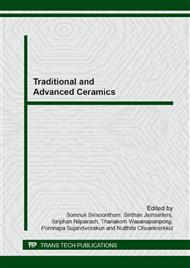p.127
p.132
p.141
p.147
p.153
p.159
p.164
p.170
p.175
Microwave Assisted Method on the Morphology of Aluminium Doped ZnO Nanocrystals
Abstract:
This study investigated the effect of aluminium dopant on ZnO morphologies synthesized by microwave assisted method. The precursors used were Zn (NO3)2.6H2O, NaOH and AlCl3.6H2O. The conditions for microwave heating were 160 and 640W, 10 min with 5s ON/15s OFF step. Microwave assisted heating generates heat to activate the formation of ZnO. Phase study was carried by X-ray diffraction which confirmed the formation of wurtzite structure of ZnO for all synthesized conditions. Microstructure was studied by a scanning electron microscope which revealed different crystal morphologies of ZnO at different amount of Al doping concentrations. ZnO rod was about 3-5 μm in length and 200 500 nm in cross section with hexagonal crystal plane. During microwave heating, nucleation of ZnO rods started at a point leading growth into larger flowers. In this work, it was suggested that Al acted as a nucleating agent and affected the c-axis orientation for ZnO crystal growth. Small needles/rod-like crystals were observed probably due to fast nucleation and a decrease of growth on (002) plane.
Info:
Periodical:
Pages:
153-158
Citation:
Online since:
April 2014
Authors:
Keywords:
Price:
Сopyright:
© 2014 Trans Tech Publications Ltd. All Rights Reserved
Share:
Citation:


